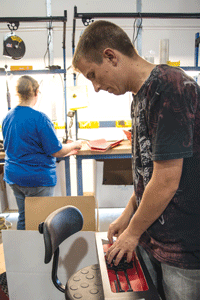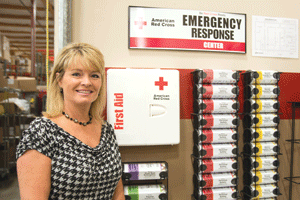
“The thought is if we can find a local business that is providing a supply chain element for our manufacturers, that’s much better than them looking elsewhere for that product,” Moore said.
Aimmco, an injection molding thermoplastics company based in Woodland, is one of the local companies that has seen its business benefit from producers looking to bring their production back to the United States.
“We’re seeing quite a few Fortune 500 companies as well as mom-and-pop companies that have been doing business overseas in an attempt to save costs, coming to us over the last two years looking for solutions to their delivery headaches,” said Brian Hug, Aimmco’s sales manager. “Those headaches run the gamut from speed-to-market, to communication, to costing.”
“The economic climate right now,” added Moore, “is such that the U.S. dollar is weak. And if there’s a silver lining to that, it’s that there’s less cost advantage to producing overseas than there was five or ten years ago.”
In addition to cost, Moore said manufacturers are seeking greater control over the process. Producing a part in China, she explained, doesn’t allow for the flexibility manufacturers need these days.
“In China, it could take 30-45 days to make a part, then it’s on the ocean for 30 days, so that’s two months from the time the order is placed to the time you get the order. That means companies have to keep more inventory on hand,” so there is less opportunity to make adjustments or fine-tune the product, she explained.
The advantage of being a nearby, high-quality producer has helped Aimmco serve many clients who want to bring business back, closer to home.
“The way we built our business,” said Hug, “is to be able to respond very quickly, engage with our customers on a technical level and understand their needs, so we can provide a finished part in a quick period of time.
“Customers,” Hug continued, “are realizing the total cost of doing business overseas. It’s not just the tool and the part, there are also unaccounted for costs. You can have a quality part made at a decent cost anywhere in the world. But the bottom line is that people do business and have business relationships with other people they trust. We’ve worked hard to build and demonstrate that trust.”

“You’d think that competing with big companies like Johnson & Johnson, they wouldn’t be able to compete,” said Moore, adding that they do compete, and their business is growing.
Another Vancouver-based company, Last U.S. Bag, changed its company name when everyone else started going offshore.
“Twelve years ago,” said company President Will Macia, “we were looking at our competitors going out of business due to offshoring. We thought the fact that we were the ‘last U.S. bag’ was funny, and it (the name) stuck.”
Last U.S. Bag is a textile manufacturer that makes a wide range of products, from children’s backpacks to military tactile bags employed in the field in Afghanistan. And although the company tries to produce as much as possible locally, Macia said, “We do have some production in Asia, just because a lot of the infrastructure in the U.S. is no longer available.”
“Over the last 20 years we’ve conditioned the consumer to buy at a low price. It’s going to be slow to re-condition people to reinvest in our manufacturing base,” Macia explained. “Right now, it’s hard to produce here. It’s difficult for us to battle the labor discrepancy between Asia and the U.S., but we’re all trying to make it happen. We’re starting to reinvest, and build out the capabilities that we have basically outsourced for a long time.”
What’s making this shift possible, said Macia, isn’t so much that things in the U.S. are getting easier, but that outsourcing is growing more expensive and more complicated.
“Labor there (overseas) is slowly getting more expensive,” he said. “And when you factor in the cost of fuel for freight, it starts to weigh on incremental costs.”
But even more than financial cost, Macia added, echoing Moore and Hug, speed and flexibility make the real difference.
“Our number one advantage is just-in-time ability,” he said. “If we’re really efficient and we’re students of manufacturing and we want to learn and improve the process, we can close that gap. And if we invest in our local area it strengthens our community.”




